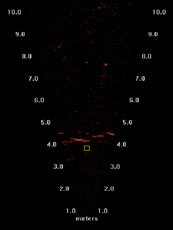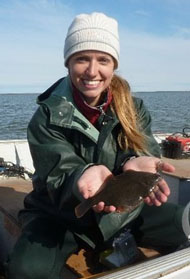
DIDSON image showing four fish passing the sonar.
This project is a collaboration with the Alaska Department of Fish & Game, who uses dual-frequency identification sonar (DIDSON) to enumerate sockeye, chum, and Chinook salmon in the Nushagak River, Alaska. My MSES thesis uses Nushagak DIDSON recordings in conjunction with tide, temperature, and light intensity data in order to determine how local environmental conditions may be affecting hourly passage rates of these three species. A second objective of my thesis is to classify spatial clustering and schooling behavior of salmon as they pass by the sonar site. The goals of this project are to: 1) improve our ability to estimate escapement, and 2) obtain a detailed pattern of fine-scale movements — both of which have implications for salmon management.

Sam Simpson with Arctic flounder caught near Barrow, Alaska.
Sam Simpson: I grew up in Alaska and am interested in our state’s fish resources, particularly adult salmon. Alaska is home to some of the healthiest salmon runs in the world; as more people look to develop Alaska, detailed knowledge of local conditions which might affect salmon distributions is necessary.
